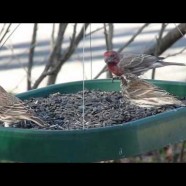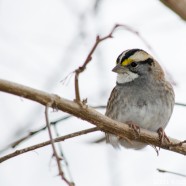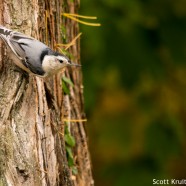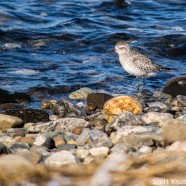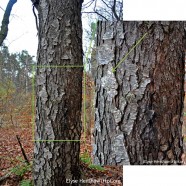Purple Finch vs House Finch comparison with feeder birds
Here we have a female Purple Finch (Haemorhous purpureus) feeding throughout the video along with a female House Finch (Haemorhous mexicanus) and a male House Finch later on. A Tufted Titmouse (Baeolophus bicolor) and Black-capped Chickadee (Poecile atricapillus) also make an appearance among the common feeder birds visiting this tray of sunflower seeds. Note that the female Purple Finch is larger and bulkier than her House Finch counterpart. She has more boldly defined colors in all regards with additional heavier and stronger facial and head markings. Take a few watches to get a feel for...
Read MoreSpring-like White-throated Sparrow
It feels like nobody told this gorgeous White-throated Sparrow that it was not spring time! I thought it was looking rather dapper for December standards and snapped this shot while it looked me over. Unlike this friendly bird I was not dressed to shine on a chilly and overcast day. I am jealous of you folks who get to see the species year-round. Scott Kruitbosch Conservation & Outreach Coordinator
Read MoreFemale White-breasted Nuthatch
This looks to be a female White-breasted Nuthatch (Sitta carolinensis) – can you determine why? The crown stripe on this bird is gray rather than the solid black of a male. This lovely lady inquisitively watched me for a moment before continuing to forage with what seems to me to be a tad higher than average numbers of the species in our region. Scott Kruitbosch Conservation & Outreach Coordinator
Read MoreBlack-bellied Plover (Pluvialis squatarola)
Even when the Black-bellied Plover (Pluvialis squatarola) is not quite living up to its name during the non-breeding season it still has a surprisingly appealing look. The plumage may initially seem dull but when it takes flight it flashes some of that namesake color with its black axillars and an always white rump and tail. The species can be found hanging out on the Atlantic Coast in many locations during the late autumn and winter. It is a bird we record nearly year-round for our work in the Audubon Alliance for Coastal Waterbirds.
Read MoreWinter Tree ID
As autumn is winding down in Western New York, more leaves are on the ground rather than on the twigs of the trees from which they came. With no leaves, tree identification throughout the late fall and winter can be rather challenging. However, paying close attention to a tree’s bark can help identify it, as each species has its own unique bark as they do leaves. Take the tree pictured here for example. It has flaky, reddish bark in places making it look somewhat similar to a Black Cherry (Prunus serotina). But, there are several flat pieces with horizontal lines going across them as...
Read More



